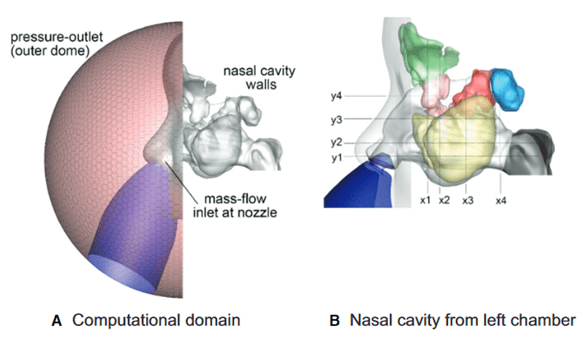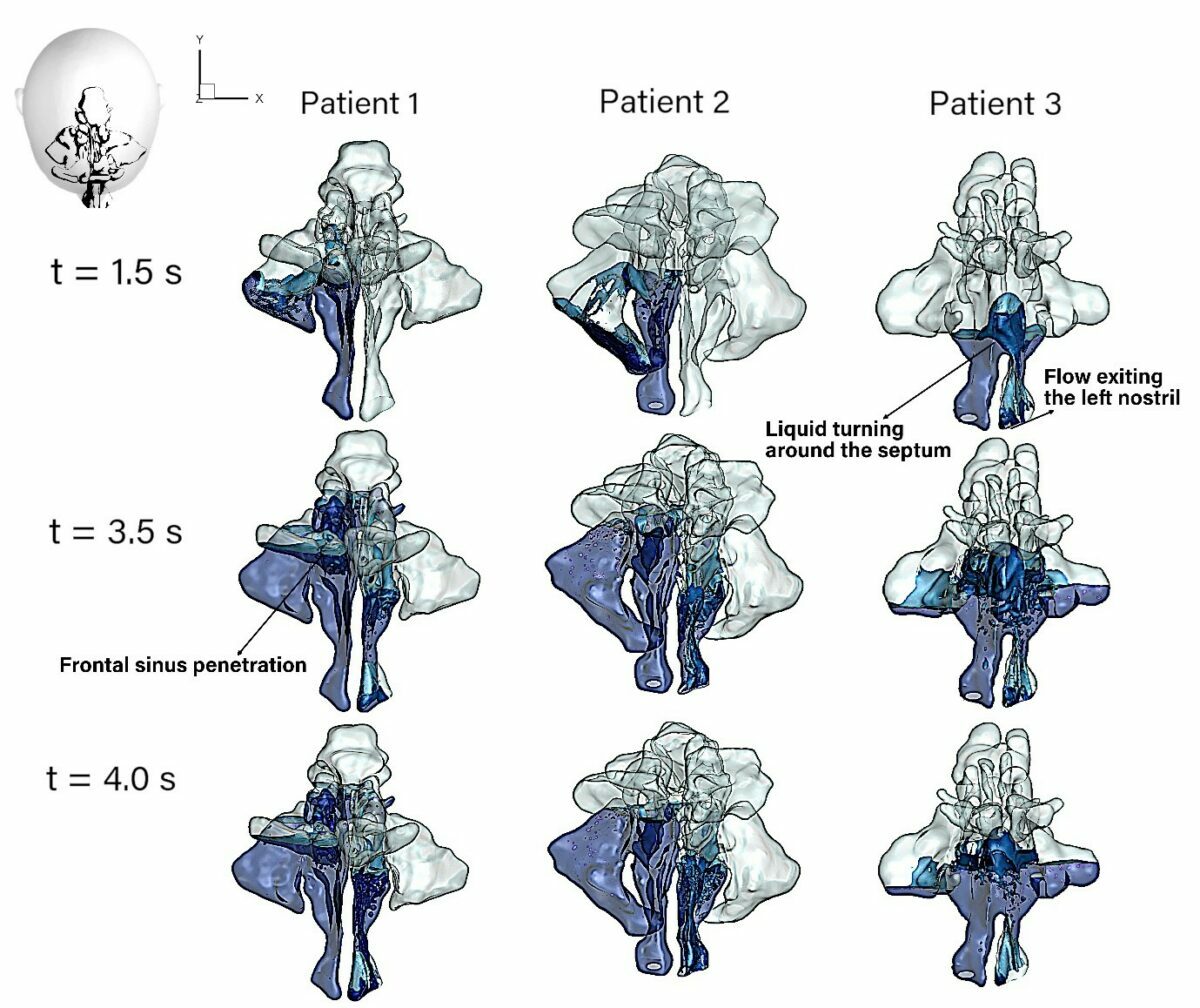Flow Visualization of Nasal Irrigation Leads to New Squeeze Bottle Design
Nasal saline irrigation is a therapy technique where a liquid solution cleans the nasal passages. It can be used to alleviate congestion and sinus irritation by forcing the saline through the nasal cavity washing out thick or dry mucus, and pollutants such as pollen, and dust particles.
Squeeze bottles deliver the solution into the nasal cavity as liquid jets, which have been shown to reduce allergic rhinitis symptoms and can be used by patients with good compliance and minimal side effects.[1] However, the reasons why squeeze bottles were effective for nasal irrigation were not well known from an engineering perspective.
Kiao Inthavong and his CFD Research Group (RMIT University) team wanted to better understand the flow dynamics of liquid jet irrigation. Using CT scans of actual human patients from ENT clinicians, his team reconstructed a computational model of a human nasal cavity, and applied the multiphase Volume Of Fluid (VOF) approach to track the liquid-air interface of the nasal irrigation within the human nasal cavity domain.

Fig 1. A) Computational model of the nasal cavity with the squeeze bottle inserted into the nostril. B) The internal nasal cavity with colors depicting some anatomical features, including the frontal sinus (green), sphenoid sinus (blue), maxillary sinus (yellow), and the nasopharynx (dark grey)
The simulations are inherently transient applied with small time steps, and with multiphase flows, double precision was used. This led to huge datasets per study. Tecplot 360’s ability to handle large datasets allowed the entire set of results to be loaded and the time-dependent data to be processed efficiently.
“We were impressed by the powerful capabilities of Tecplot 360 to handle the dataset”, Kiao remarked. “Furthermore, we used the varied automation tools available, including PyTecplot connected with Python, and Macro Scripts, which has become part of our established workflow.”
The flow visualization from CFD modelling with the VOF method revealed the liquid jet behavior within a human nasal cavity. The overflow and flooding effects helped increase sinonasal surface coverage, residence times across the mucosal surfaces, and shearing force of irrigation.

Fig 2. Liquid surface coverage inside the nasal cavity viewed from the top of the head for three patients that had undergone FESS (Functional Endoscopic Sinus Surgery). The blue color represents the liquid region.
The applied industry related research project outcomes were published in two leading journals, the International Forum of Allergy and Rhinology[2], and Journal of Biomechanics[3] . Later, in collaboration with ENT Technologies, the results were used by the company to redesign their squeeze bottle. The new larger volume bottle and ergonomically designed received huge success anecdotally by patients and the new bottles are expected to come out to market.
[1] Piromchai P, Kasemsiri P, Reechaipichitkul W. Squeeze Bottle Versus Syringe Nasal Saline Irrigation for Persistent Allergic Rhinitis – a Randomized Controlled Trial. Rhinology. 2020 Oct 1;58(5):460-464. doi: 10.4193/Rhin19.308. PMID: 32427228
[2] Inthavong, K., Shang, Y., Wong, E. and Singh, N., 2020, January. Characterization of Nasal Irrigation Flow from a Squeeze Bottle Using Computational Fluid Dynamics. In International Forum of Allergy & Rhinology (Vol. 10, No. 1, pp. 29-40).
[3] Shrestha, K., Salati, H., Fletcher, D., Singh, N. and Inthavong, K., 2021. Effects of Head Tilt on Squeeze-bottle Nasal Irrigation–A Computational Fluid Dynamics Study. Journal of Biomechanics, 123, p.110490.
 The CFDResearch group is a collaborative research space at RMIT University in Australia, led by Dr Kiao Inthavong. The group uses CFD and experimental flow visualization techniques to investigate multiphase flows in the respiratory system, indoor airflow behavior, and fluid-particle dynamics. We use Tecplot 360 as the primary post processing tool to analyze complex data from CFD simulations. The main features we use are automation through Macros and Python scripting to handle large data sets, helping to generate streamlines, contours, and overlaying them onto the shaded geometries for visualization.
The CFDResearch group is a collaborative research space at RMIT University in Australia, led by Dr Kiao Inthavong. The group uses CFD and experimental flow visualization techniques to investigate multiphase flows in the respiratory system, indoor airflow behavior, and fluid-particle dynamics. We use Tecplot 360 as the primary post processing tool to analyze complex data from CFD simulations. The main features we use are automation through Macros and Python scripting to handle large data sets, helping to generate streamlines, contours, and overlaying them onto the shaded geometries for visualization.
In 2017, we initiated a research program that involved a cross-disciplinary engineering-clinician program on “Engineering Solutions Impacting Clinical Outcomes (ESICO)” that led to the foundation of SCONA (Society of Computational Fluid Dynamics of the Nose and Airway). Throughout this research program, we have helped clinicians to understand nasal diseases, their therapy through drug delivery, and support treatment planning in functional rhinosurgery through CFD visualization with Tecplot 360 to generate images and animations and its interpolation function to compare data sets.




